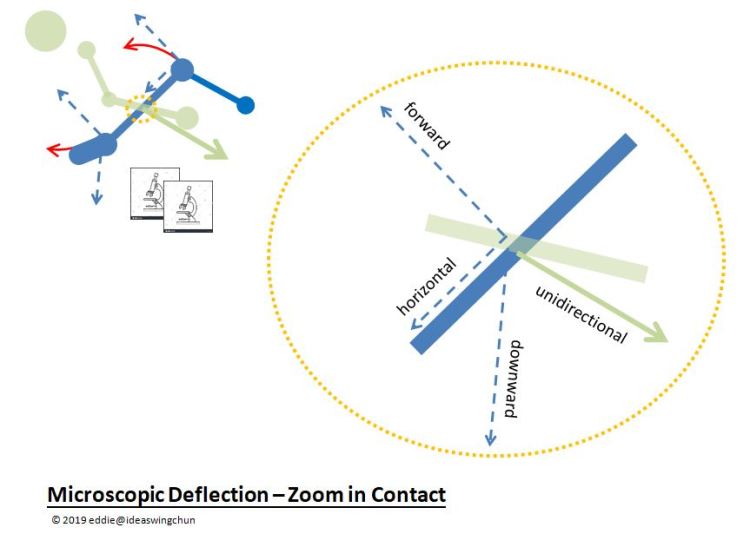“Why are multi-directional forces a desired advantage? When the opponent exerts a strong force on your forearm, at any particular moment the force is strong in one direction only. However, at that same particular moment your contact with him is rich in diverse forces – some are in directions appropriate for containing his unidirectional force, some are in other directions from which attacks can be launched as desired.” – extracted from the post Multi-directional Forces in the Arm – Pinning Elbow Tip in Space.
In this post, let us zoom in and take a microscopic view on what’s happening at the contact in the forearm (referred to as forearm contact hereafter).
In a normal force exchange – in this case, in the forearm – each of the two parties is detecting and locating the line of force of the other one, so that his force can exert greater pressure head-to-head (over enough duration of time) going to beat the opponent. Force under such intent is basically unidirectional at the forearm contact. In a sense, you can argue that it is the head-to-head intent that has “caused” the force being unidirectional.
With multi-directional forces in place from the point-linked mechanism, there can be no moment only one direction exists for my force at the forearm contact. Rather, looking through the microscopic lens, the direction of my “force” at the contact is ever changing, never settling down to be targeted, to be locked head-to-head. Yet there seems no obvious physical movement in appearance. My “force” is actually a composite of forces in different directions at play, in such a way that there are always forces in directions other than the head-on, but laterally disrupting the incoming unidirectional force.
Still through the microscopic lens: The incoming force heading towards its ONE direction finds no exertion point (not enough duration of time to maintain head-to-head), yet it can’t stop nor adjust its course of movement instantly. It will then be easily deflected at the forearm contact by my active, ever-changing composite force. The opponent might be able to react quick enough to avoid being displaced by the deflection. Nevertheless, his balance is always disturbed because whenever he intends to force through the contact, he has to take his force back right away due to the absence of an exertion point; otherwise his force will fall into the void and be greatly deflected, he himself obviously losing balance and exposed to further attack. Even so (that is, the opponent manages to keep his position and be in contact), his force is still being microscopically deflected – my multi-directional forces disrupting his unidirectional force within my small but soft surface of the contact – and still resulting in his force “pressing into the void”. I would term it metaphorically as the “microscopic deflection”. When this happens in sticking hands, the scene will look interesting: There seems no enormous forces being exchanged; only that the opponent appears not able to grasp and maintain his balance, as seen in his staggering footsteps – it looks like “dancing” more than fighting!
Contact with opponent in this mode is, in my opinion, regarded as more advanced due to its higher level of control over the opponent. While contact exchanging power is certainly desirable and in fact the necessary basics, contact enabled with microscopic deflection should also be sought after, again in my opinion, as a gateway to the artist skill of Chu’s Wing Chun.
And from this we will turn to the “wrapping intent” in the next post.
CONCISE GUIDE: (All is mind activity.) Operating in the point-linked mode, always have the intent of disengaging from the opponent’s line of force at the forearm contact, yet still feel safe with your “control zone” up and running.
2019.03.06

